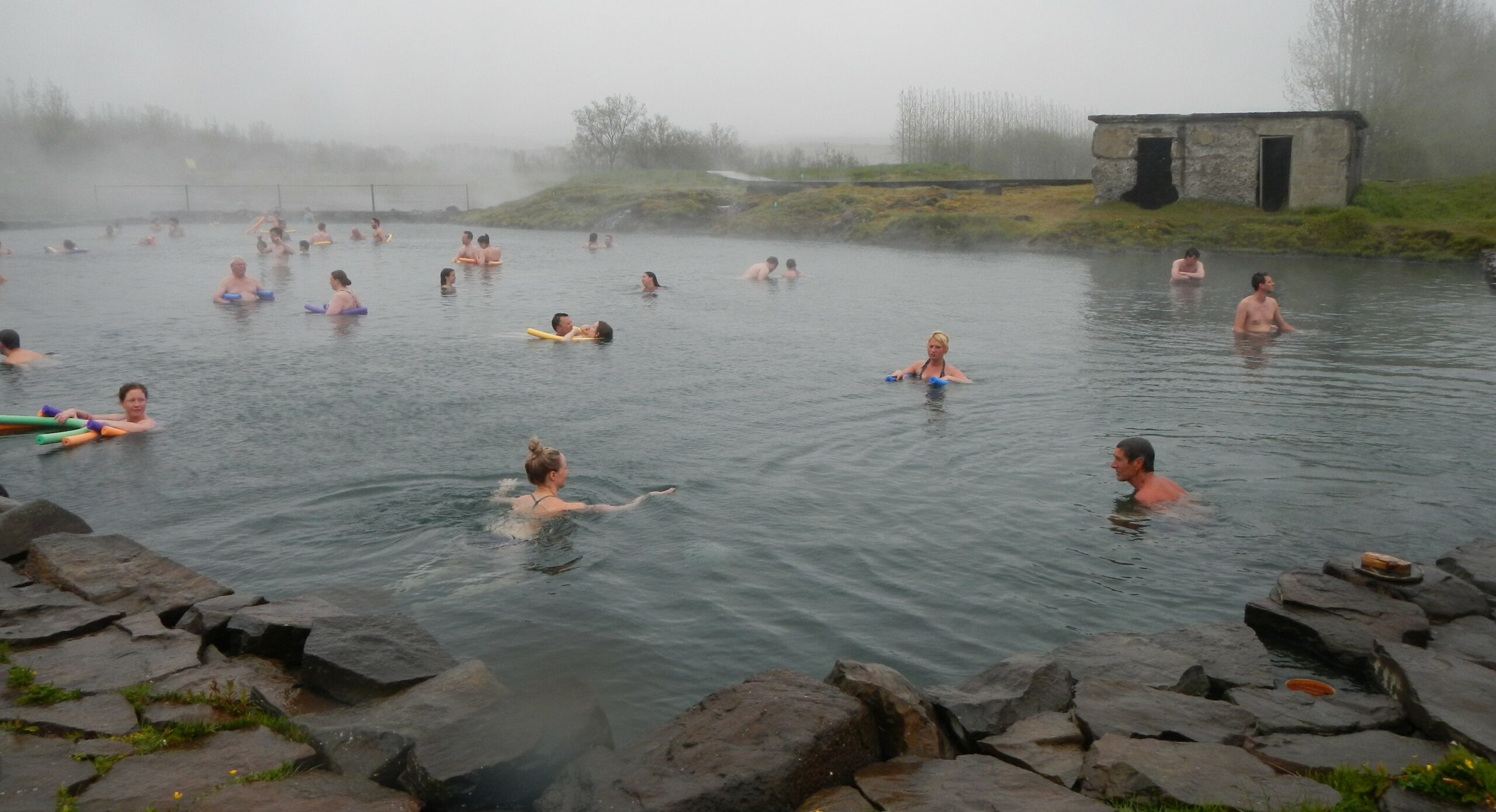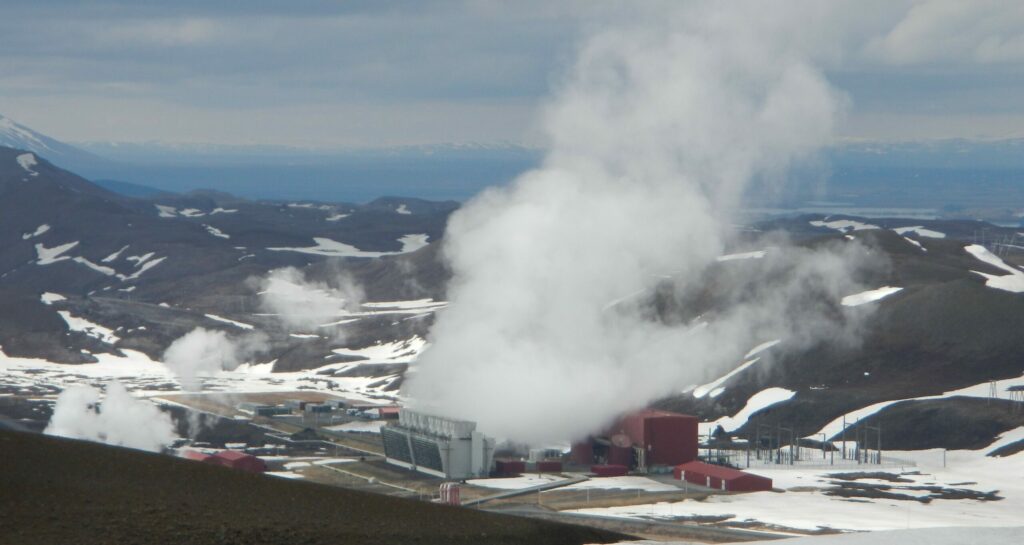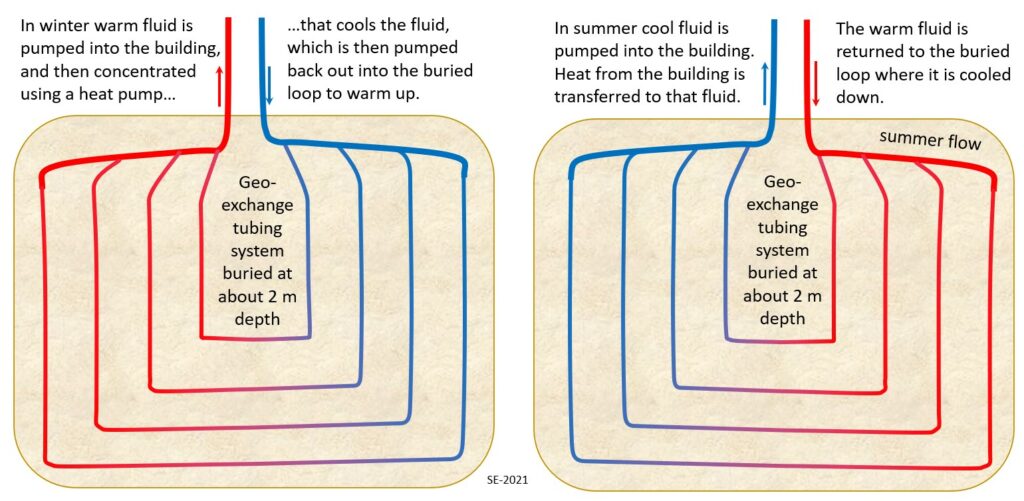9.4 Geothermal and Geo-Exchange
Steve Earle
Geothermal energy is heat that originates within the Earth—which includes heat left over from the original formation of the Earth and heat produced by radioactive decay—and is either naturally present at surface or is accessed at depth by drilling. We can harness this energy where there is higher than average heat flow from depth, and this is most common in areas near to active volcanoes. About 50% of all geothermal energy use is for heating buildings and other infrastructure, about 33% for hot pools and spas (Figure 9.4.1), while only about 17% is used to generate electricity. In many cases the left-over heat from electrical generation facilities is used for district heating or for swimming and bathing facilities.

A geo-exchange system (a.k.a. geothermal heat pump, or ground-source heat pump) is not based on geothermal energy at all. Instead, geo-exchange relies on the relatively constant temperature of the ground at depths between about 1 and 5 m, and that temperature is maintained by energy from the sun. Geo-exchange is used for either heating or cooling, or both.
Geothermal
In the context of generating electricity, geothermal heat is used to boil water or some other fluid to power a turbine. In the case of very hot sources, water piped to surface from depth will spontaneously convert to steam because of the reduction in pressure. If the water from depth is less than about 180° C it won’t spontaneously boil but can be used in a binary cycle system to heat a working fluid, such as pentene or toluene, that will boil at a lower temperature than water.

The components of a typical geothermal system are illustrated on Figure 9.4.2. The heat at depth (hundreds to a few thousand metres) is accessed via deep production wells. Water from within that rock (5) is pumped to surface and its heat is used to boil the working fluid to power the turbines (4). The original water is returned to the ground via an injection well (6) along with any additional surface water needed to maintain volume (1). Most geothermal plants have numerous production wells (dozens in some cases). It is common for wells to be cycled on and off to allow for recovery of the heat reservoir around them.
The Krafla power station in northern Iceland (Figure 9.4.3) is a 60 MW flash steam system (the hot water from depth boils at surface). It is situated in a very active volcanic region on the mid-Atlantic spreading ridge. An eruption episode that lasted from 1975 to 1984 almost led to cancellation of the project while it was under construction.

The contribution of geothermal to total electricity production is important in some countries, especially in Iceland, where 30% of electricity is generated by geothermal (with most of the rest coming from hydro), and also the Philippines, at 27%, and El Salvador at 25%. In Costa Rica, Kenya and Nicaragua and New Zealand geothermal makes up 14, 11, 10 and 10% of electrical energy.[1] These are all countries with active volcanoes and hence significantly high heat flow.
In the past 10 years global geothermal energy capacity has grown by an average of 3.75% per year. That is significant growth, although lower than for wind and solar, both of which have grown by an average of 20% per year in this century. But the potential for sustained growth is limited by the limited geothermal resource, and by the high capital cost of geothermal facilities.
Exercise 9.4 Geothermal Origins
As noted above, a significant proportion of the electricity is from geothermal sources in Iceland, Philippines, El Salvador, Costa Rica, Kenya, Nicaragua and New Zealand. Explain how the plate-tectonic situation in these regions contributes to that source of energy.
Exercise answers are provided Appendix 2.
Geo-Exchange
The first several metres of the ground beneath us represents a reservoir of thermal energy that is maintained by heat from the sun and stays nearly constant year-round. We can take advantage of that thermal reservoir by living in caves or—like Hobbits—digging deep into the sides of hills to build homes. Alternatively, we can stay above ground and install plumbing systems that allow us to tap into that stored warmth and bring it inside. The concept of geo-exchange is illustrated on Figure 9.4.4. An exchange loop can be vertical, with pipes installed in drilled holes, or horizontal, with pipes installed in an excavation at a depth of around 2 m.

As shown on Figure 9.4.5, a geo-exchange loop can be used for both heating and cooling. For heating relatively warm fluid is pumped from the ground and then passed through a heat exchanger and/or heat-pump in the building to provide heating. For cooling relatively cool fluid is pumped from the ground and then passed through a heat exchanger for cooling. In fact, the “relatively warm” and “relatively cool” fluid may be approximately the same temperature, but it will be warmer than the outside air in winter, so useful for heating, and cooler than the outside air in summer, so useful for cooling.

Geo-exchange is not a source of energy, but it is a way to provide significant savings in heating and cooling energy costs, both financial and from the perspective of climate change and the environment. According to the Geothermal Exchange Organization, a geo-exchange system can save building owners between 30 and 70% in heating costs and between 25 and 50% in cooling costs.[2] The organization states that there are currently 750,000 geo-exchange systems in place, although it isn’t clear about what date or which jurisdiction that number refers to.
Media Attributions
- Figure 9.4.1 Photo by Steven Earle, CC BY 4.0
- Figure 9.4.2 Modified by Steven Earle, CC BY SA 4.0, based on EGS Diagram by Fishx, 2009, CC-BY-SA-3.0, via Wikimedia Commons, https://commons.wikimedia.org/wiki/File:EGS_diagram.svg
- Figure 9.4.3 Steven Earle, CC BY 4.0
- Figure 9.4.4 Modified by Steven Earle, from Loop Diagrams by Wgisol, 2015, CC BY-SA 4.0, via Wikimedia Commons, https://commons.wikimedia.org/wiki/File:ETI-FS_Loop_Diagrams,_01.26.11.jpg
- Figure 9.4.5 Steven Earle, CC BY 4.0

